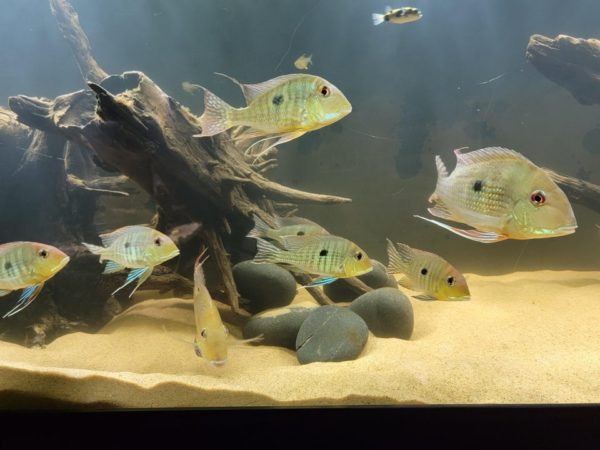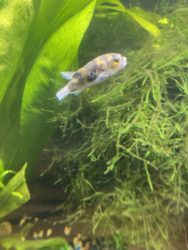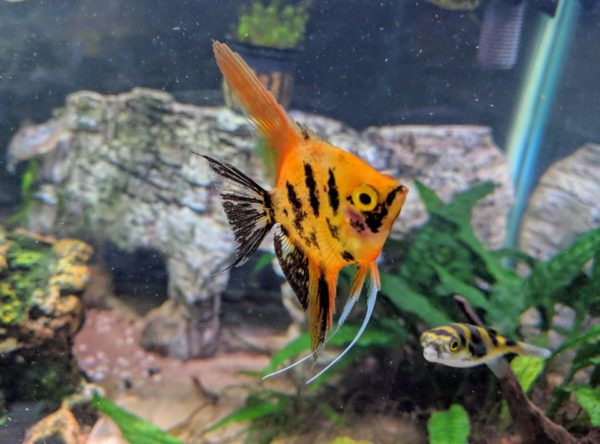Today our topic is Amazon Puffer, as you can guess from its name it is native to the Amazon River. If you are new in the fish-keeping world and want to learn more about these fish then continue reading this article. Here we will discuss everything related to Amazon Pufferfish, and you will be left with a lot of knowledge about these species.
Table of Contents
Amazon Puffer: A Quick Summary
Amazon puffers are freshwater fish native to South America. They are known for their distinctive puffed-up appearance and their ability to inflate their bodies as a defense mechanism. Amazon puffers are best kept in a well-planted tank with plenty of hiding places and a temperature range of 72-82°F.
They should be fed a varied diet including live, frozen, and dried foods.
Amazon Puffer Overview
Amazon puffers are widely known as Colomesus asellus, and are very unique compared with other puffers. These are South American species. They do not have any specific native habitation type. They can be found in any fast-moving water, be it with vegetation or not. The water can be hard, acidic or soft.
These are the smallest type of puffers that can grow a maximum of up to 8cm. Almost all puffers have yellow and greenbacks and white bellies, but they have different patterns, which is why people often struggle to distinguish between their types. Amazon puffers are distinguished by their five stripes along the body. And it is actually almost impossible to tell the male and female Amazon puffers apart, just like with other puffer types. An interesting thing about these fish is that they are one of the few fish that can actually blink and close their eyes.

Behavior of Amazon puffers
It might be a little difficult to keep Amazon puffers especially for those who are known to the fish keeping world. But these are very fun fish to keep, as they are very curious and intelligent. They will very closely inspect anything that gets into the tank, with their big eyes. Also, they start to recognize their owners pretty fast. They are always on the move and are swimming all day long.
As they are very curious they always need something new in the tank, so when you see your Amazon puffers staring the glass it means they are bored. So add some new decorations in the tank.
Tankmates for Amazon Puffer
Amazon Puffers are very active but at the same time very peaceful. You can keep these fish in a community tank with other species, but it is recommended to keep them in a single species aquarium. Also, it is not recommended to keep them with slow fish. If you want to get Amazon puffers then you better keep them with only in the group of Amazon puffers. Or you can keep them with short-finned and fast-moving fish. You can keep them with for instance, medium-sized characins, barbs, larger rasboras, and peaceful Rams or Apistogramma.

When Amazon offers sense danger they can inflate with water or air and become a few times bigger than their actual size. This is done to scare the opponent and also to be hard to get swallowed.
The diet of Amazon puffers
Amazon puffers are omnivores, which means they eat shrimp, snails, warms, etc. In the tank you should feed them with crunchy food, it can be crab legs, mussels and so on. The crunchy food can maintain their sharp teeth. As with other types of puffers, their teeth will grow continuously and become a problem for the fish, so that is why they need to be kept ground down. If their teeth will grow too much they will not be able to eat and will starve. Also, to avoid that you can trip their teeth with cuticle clippers, I know this may sound weird, but that will do only good to the puffers.
Tank requirements for Amazon puffers
These are very active fish species and should be kept in groups, you can keep them at least in a group of three, but more is preferable. They need large aquarium so it is better to get a t leas 120cm tank. As for the water type, it doesn’t really matter what hardness or temperature it has, but the quality of the water matters. So you should always have good cycled water without any nitrite or ammonia. Also, you need one ore even more powerful canister filter. To be sure that you provide the best quality water it is better to test it from time to time. These fish love aquarium decorations see it is recommended to have plenty of plants, leaves, and rock so they will have a lot of things to explore. But it is also important to keep a wide space for swimming and they like swimming in a current. So you can put the filter in a way that it will create a current.

How to breed Amazon puffers?
It is unfortunately impossible to breed them in a tank. As the eggs are too small. Before they become real fish they pass through a planktonic phase that is why it is impossible to breed them in a tank.
Common Diseases And Their Treatment
If your tank has a diseased Amazon Puffer, it can damage the entire fish ecosystem. Thus, you must make a detailed visual examination to recognize the fish’s skin abnormalities and other behavioral changes. In addition, it would help you deter the diseases from spreading to other aquarium inhabitants.
Abnormalities in the fish body and their behavior can be the obvious clues for any infection. Since Amazon Puffers fish are very active species, they can be the symbols of sick fish when they show floating, sinking, or hiding behavior. Moreover, when they are under stress, they start puffing a lot.

Their body can spot lesions and puffiness when parasitical infections or chemical frustration has occurred. Since Amazon Puffer does not have any gill covers or scales, they are very sensitive to diseases. If you have varieties of species in your fish tank, then your puffer would be the first fish to show signs of having common fish diseases.
In case they acquire ick disease, the puffers would start twitching and rubbing around the aquarium surfaces. When an Amazon Puffer has a parasitic, fungal, bacterial, or viral disease, it can simultaneously influence the body’s various systems. And these microbial diseases are highly transmittable and make other fishes in the aquarium sick in a short period.
Nonetheless, they respond well to fish medications and antibiotics so that they can heal quickly. However, you should not use any treatment solution involving copper if you are keeping Amazon Puffer. As an aquarist, make sure the water doesn’t have a high level of ammonia in the water, which can harm the puffer.
They might sport red streaks on the body with swollen red gills. If they have clamped fins, it indicates that the pH level of water in the tank is not optimal. While giving live foods such as small fishes, shrimps, worms, you should be careful as they can pass the disease to the puffer, which can eventually spread in your tank.
Facts About Amazon Puffers
- Amazon Puffers are quite sociable, so they are mostly kept in groups. Thus, never keep them in solitary, which can make them feel nervous.
- Usually, Amazon Puffers can grow about 3 inches long on average, but it is recorded that they can grow up to 5 inches too.
- Their life span can get up to 8 to 10 years without having any diseased condition or physical ailment.
- Amazon Puffers are omnivorous in nature. However, they like to have meats in their diet consistently. And having crunchy food is very helpful to grind down their teeth.
- Amazon Puffers are swimmer fishes, so they need a good current in the tank water.
- In contrast to other freshwater puffers, Amazon Puffer does not guard their eggs.
Are Amazon Puffers Right For You?
For the most part, it is quite easy to keep the Amazon Puffer because they are migratory fishes in nature that are originated from the wild water environments. Thus, they are very adaptable to various environments, making them suitable species to keep in any tank environment and water parameter in a healthy condition.
However, caring for them is quite essential since they are scaleless species prone to acquire various diseases. Moreover, they have continually growing teeth, which you might have to clip or trim physically once in a while so that they can eat and breathe properly.
You might need a very spacious aquarium and filter the water more frequently, as they are quite a messy eater. If you can take up all these challenges, then adding Amazon Puffer to your tank can be an exciting journey as an enthusiastic aquarist.

FAQs
How Long Does An Amazon Puffer Live?
The Amazon Puffer fish can live quite a long life in an aquarium. Some recorded to live about ten years and more if kept in an appropriate living condition in the tank. Their survival instinct is unique, and they have many other defense mechanisms that help them keep out of getting eaten.
As their name suggests, the Amazon Puffer fishes can puff up inside water or air when they feel threatened by other fishes making it hard to get eaten. But, other than making themselves puffer, these fishes are also able to produce toxic substances in their flesh. So, when other creatures try to eat them, they turn poisonous.
How Often Trim Amazon Puffer Teeth?
When Amazon Pufferfish don’t continue to have an appropriate diet, it can lead to having their teeth overgrowing. Unfortunately, these elongated teeth made them unable to open their mouth to consume food. After a while, they might starve to death.
Although they can try to eat, since they cannot move their mouth, they just spit back the food. If their teeth have elongated to that extent, giving them crunchy food might not help them.
However, you have to trim their teeth manually through your hand. Some of the puffer species require a daily supply of snails to keep their diet and appetite healthy. If you cannot offer them snails very often, they would need to trim their teeth every 4-6 months.
Can You Keep One Amazon Puffer?
Amazon Puffer Fishes are very much active species in nature yet very peaceful. Some fairly active swimmers require at least more than 30 to 50 gallons of water in the aquarium to keep them. It’s best to keep them either as individuals or in groups.

If you keep them in a community tank with other species, you can keep a group of puffer together. But, generally, it’s recommended to keep them in a single species aquarium, as they are quite territorial in nature.
So, it might be possible for them to get into fights with other species. Make sure to add a lot of decorative aquarium plants and other hardscapes to block their line of sight. This way, these swimmers can have various fascinating landscapes to explore.
How Do You Feed An Amazon Puffer?
All Amazon Puffers like to feed on crustaceans and mollusks. This is because they have consistently growing teeth at their mouth front, which form a beak-like structure allowing them to chomp on the hard shells of snails. However, when they become too long, it becomes hard for them to eat.
Thus, you should trim their teeth down by feeding them all kinds of crunchy fish foods, e.g., ramshorn snails, bladder snails, freeze-drilled krill, gut-loaded ghost shrimp, glass worms, crickets, and many more.
Snails are the essential food item for the Amazon Puffer diet, particularly when they are very small. However, not every kind of snail is appropriate for them. For example, the cone-shaped snail named Malaysian Trumpet snail is not suitable for baby puffers to feed on due to their very hard shell.
If your puffer has grown properly, the matured and large Amazon Puffers can feed on varieties of crunchy foods such as shrimps, crab legs, mussels, scallops, oysters, clams, lobsters, squids, crayfish, etc. In addition, you can give them green food as algae wafers with other live food to keep their diet well balanced.
Are South American Puffers And Amazon Puffers Same?
Yes, South American Puffers and Amazon Puffers are the same creatures. Amazon Puffer is popularly known as Colomesus Asellus, a freshwater species generally native to tropical South America.
They are mostly found in the wild areas of the Amazon system that is Brazil, Colombia, and Peru. Therefore, they are commonly referred to as the Amazon Puffer, Peruvian Puffer, and the South American Puffer.
This fish’s family has many freshwater species originating from the sea but completely adapted to freshwater habitats in South America, Asia, and Africa. Thus, they can adapt to any water parameter effortlessly. Therefore, you might not require much water maintenance since they don’t require much water modifications.
Overall specifications of Amazon puffers
- Temperature of the tank: 72 – 82°F
- pH level of the water: 5.5 – 8
- Hardness of the water: 5 – 15°H
- Size of the tank: at least 120 cm
- Diet of Amazon puffers: Omnivores
- Breeding: Impossible in the aquarium
- Decoration for the tank: Very important to have decorations and change them from time to time
So, what do you think, will you get some Amazon puffers for your tank or not?
You might find it a little difficult at first, which is completely fine, but you will get used over time and see that you made the right choice. Hopefully, you found enough information in this article. Just be sure to keep all the aquarium requirements for them, provide them with quality water and some good decoration and they will be happy and healthy. Do not forget about their endlessly growing teeth and always try to fill their curiosity with some new decorations. Also do not forget to keep them with the right tankmates otherwise they might lose their fins. So good luck with your choice.
No related posts.
